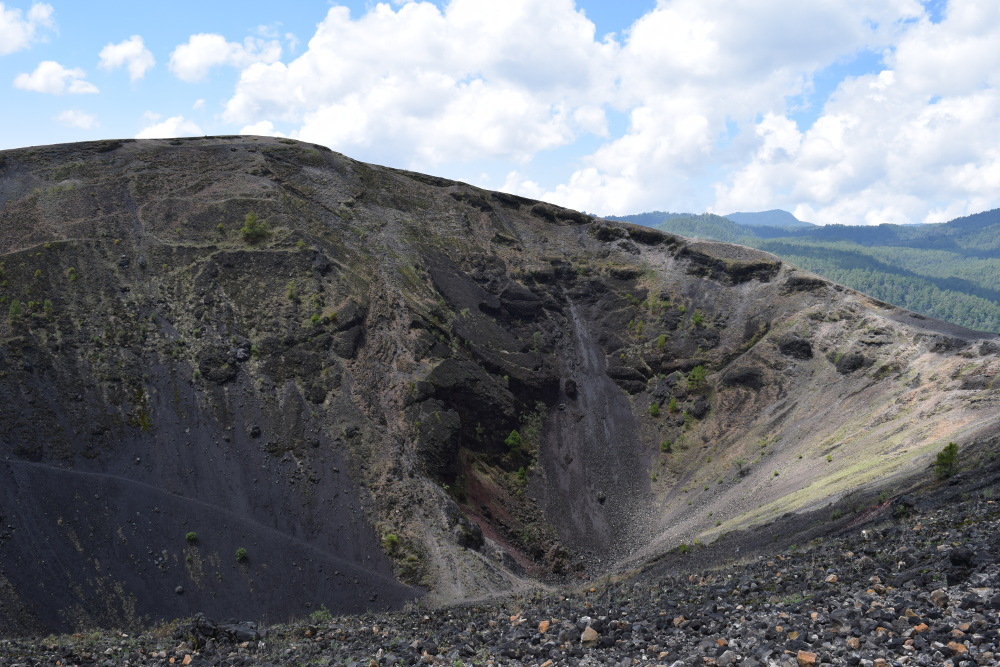 I first heard of the Parícutin volcano when I was in elementary school, somewhere around 1960. There was a story about it in one of the weekly news magazines handed out to students. The way the story went was, in 1943, this Mexican farmer went out into his corn field, and smoke started to come out of the ground. The result was a brand new volcano, the only one on this planet that scientists have been able to study starting with the initial eruption.
I first heard of the Parícutin volcano when I was in elementary school, somewhere around 1960. There was a story about it in one of the weekly news magazines handed out to students. The way the story went was, in 1943, this Mexican farmer went out into his corn field, and smoke started to come out of the ground. The result was a brand new volcano, the only one on this planet that scientists have been able to study starting with the initial eruption.
Like most children my age, I didn't have much of a concept of Mexico, let alone the State of Michoacán. Michoacán is known primarily for the cities of Morelia and Pátzcuaro, monarch butterfly reserves, and narco violence. So, Parícutin wasn't something I was conscious of until I made my first visit to Pátzcuaro and nearby Uruapan in late 2017.
Parícutin last erupted in 1952. It is officially classified as dormant, but contrary to what some local people will tell you, the ground is warm, and steam emissions can be seen.
The closest city to Parícutin is Uruapan. From there, tourists have three choices:
Angahuan, 38 km. northwest of Uruapan. When you arrive there, there will be plenty of tour guides around. Finding one that speaks English might be a challenge. (It's worth noting that for a lot of the people who live in this area, Spanish is their second language; their first language is Purépecha.) They will try to talk you into renting a horse, which is not a bad idea. It's six km. from Angahuan to the base of the volcano, and once you get there, it's a very steep hike to the crater. (Your horse won't understand English, either; you need to learn the words "vamos", "despacio", and "alto".)
Nuevo San Juan Parangaricutiro, more commonly referred to as "Nuevo San Juan", is 15 km. west of Uruapan, and the road is choked with traffic. This is the approach I took, because I had a referral to a guide there. Your chances of finding an English language guide here are even lower than Angahuan.
The advantage of Nuevo San Juan over Angahuan is, there's a road from there to the base of the volcano, so no need to bother with horses. (The last few kilometers or the road require four-wheel drive.) The advantage of Angahuan over Nuevo San Juan is, the route goes through the ruins of Viejo San Juan Parangaricutiro. Those ruins include the church, which survived the eruptions.
Zacán, 45 km. northwest of Urupan, further along the same road that goes to Angahuan. From Zacán, there is a road, passable by car, to the ruins. From there, it's a level 3 km. walk to the base of the volcano. The road continues to the east side of the volcano, but that stretch is not in good condition.
 One important note of preparation: The summit of Parícutin is 2,800 meters (9,200 feet) above sea level. So, if you go there during the winter (or even November or April), be prepared for cold weather. I was told that it snowed there in January, 2019. At any time of year, bringing water is essential. Wear shoes with good tread and ankle support.
One important note of preparation: The summit of Parícutin is 2,800 meters (9,200 feet) above sea level. So, if you go there during the winter (or even November or April), be prepared for cold weather. I was told that it snowed there in January, 2019. At any time of year, bringing water is essential. Wear shoes with good tread and ankle support.
The ascent takes about an hour and, as I wrote earlier, it's very steep. The descent takes much less time.
The road from Nuevo San Juan goes through a pine forest managed by a local Purépecha community. You'll notice that there are a couple of checkpoints on the route. They are there for a good reason. The forests in this area are targets of organized crime. Not only do they cut down the trees and steal them; they replace them with avocado trees. The local people have had some success at fighting back against this, but it's dangerous work.
Nuevo San Juan did not exist until 1944. It was set up specifically as a place for people who were displaced by the eruptions. In addition to Viejo San Juan, there was a village named Parícutin which is now underneath the volcano. On one side of the church in Nuevo San Juan, there is a diorama that shows what the Parícutin area was like before the eruption.
Nuevo San Juan has several hotels. Google Maps shows only one hotel in Angahuan. Uruapan has lots of them.


